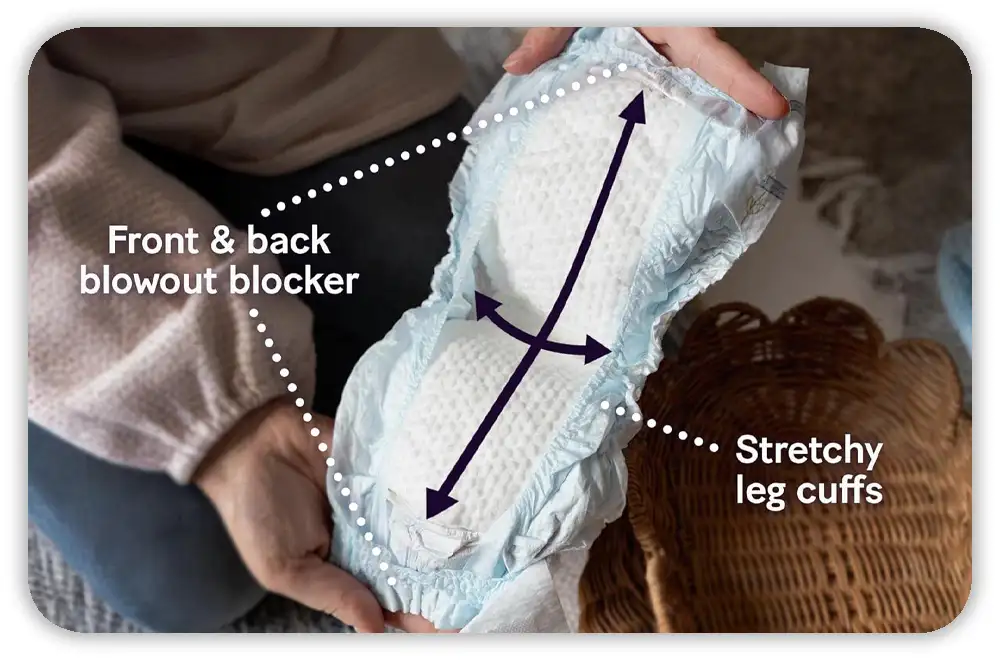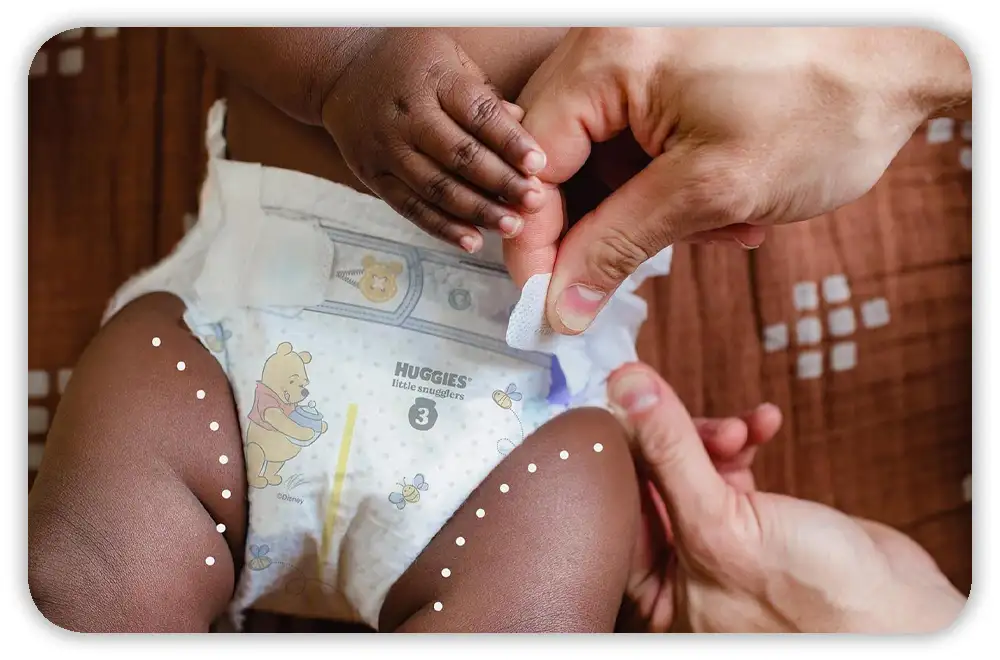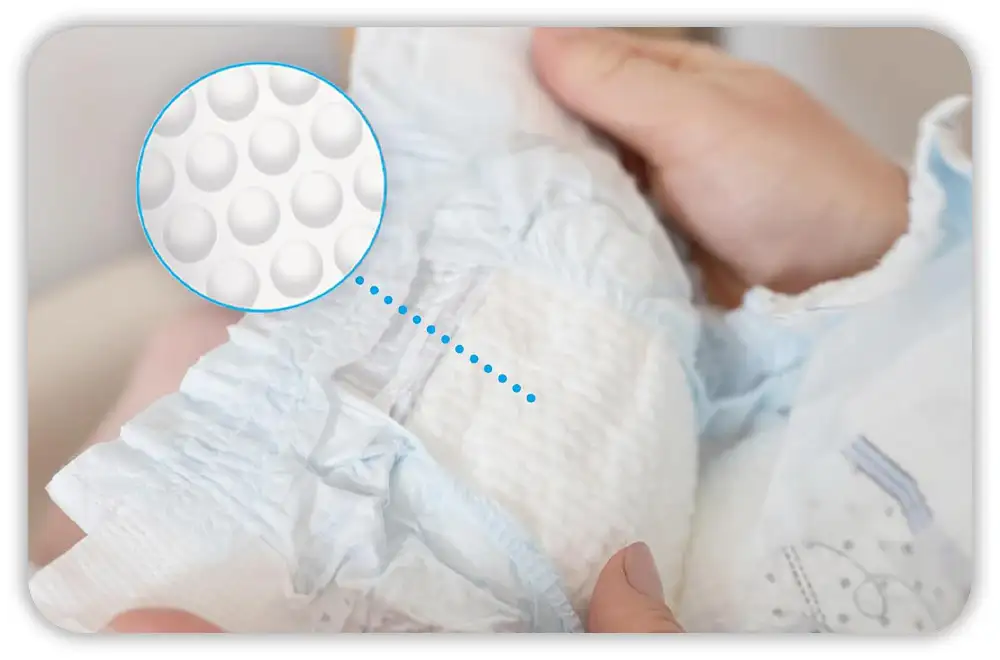Ever looked at your baby’s diaper and thought, “Are Huggies diapers safe?” You’re not alone. I’ve asked that same question at 3 a.m. while rocking my newborn back to sleep.
As a mom and writer, I’ve spent years digging into baby products. I care about what touches my baby’s skin — and I know you do too.
Let’s take a close, honest look at what’s inside Huggies diapers. I’ll share the good stuff, the things to keep an eye on, and what it all means for your little one.
Table of Contents
What Does “Toxic” Really Mean?
When we hear “toxic,” we often think of something deadly or harmful. But with baby diapers, it’s not always that simple.
“Toxic” here doesn’t mean the diaper is going to hurt your baby right away. It means it might have tiny amounts of certain chemicals. Over time, these could cause rashes, hormone changes, or other problems.
Here’s what matters: babies are more sensitive than adults. Their skin is thinner. It soaks things in more easily. And it’s still growing.
So even small amounts of a chemical can affect them more.
Plus, babies wear diapers all day and all night. That means their skin is in contact with the diaper for hours and hours. Warmth and wetness can make that contact even stronger.
That’s why moms like us start asking questions. What’s in these diapers? Are the parts safe? Are there any hidden chemicals?
What’s Inside a Huggies Diaper?
Each diaper has a few main parts. These include the absorbent core, a soft liner, leak guards, glue, stretchy bands, and a printed outside layer. Huggies lists some of these parts, which helps. But it’s not the full list.

Here’s a quick look at what they include:
| Ingredient | What It Does | Any Red Flags? |
| Polypropylene | Soft top layer that touches baby’s skin | Generally safe |
| Polyethylene | Used in outer cover and leak guards | No big concerns |
| SAP (Super Absorbent Polymer) | Locks in pee to keep baby dry | Works well, but not earth-friendly |
| Wood Pulp | Helps soak up liquid in the core | Often bleached with chlorine (see next section) |
| Adhesives | Hold parts of the diaper together | May have trace chemicals |
| Colorants (inks, dyes) | Print cute designs on the outside | Can be risky if not labeled “non-toxic” |
| Fragrance (in some lines) | Adds a light scent | May cause rashes or skin issues |
Most ingredients are common in diapers. But things like glue and dye can vary in safety — especially when brands don’t say what’s inside.
What Do “Chlorine-Free” or “Hypoallergenic” Mean?
These labels sound safe — but they can be tricky.
“Chlorine-free”: Huggies uses ECF, or elemental chlorine-free. This means they don’t use pure chlorine gas. But they still use chlorine stuff. It’s not the same as TCF (totally chlorine-free), which is what green brands aim for.
“Hypoallergenic”: This means the diaper is less likely to cause a reaction. But there’s no set rule. And every baby’s skin is different.
“Fragrance-free”: Some Huggies lines, like Special Delivery, skip scents. Others, like Snug & Dry, may still include them unless it says otherwise.
As a mom, I’ve learned to check more than just the label. I watch how my baby’s skin reacts. Because what works for one baby may not work for another.
What’s Not on the Label: Chemicals Found in Diapers
Here’s the tricky part — not everything in a diaper is on the label.

Some chemicals sneak in during the process. Others come from glue, scent, or materials. These are called residues or contaminants. They aren’t added on purpose, but they matter just as much.
And since babies wear diapers almost all day, even small amounts can build up over time.
Let’s go over the most common hidden chemicals — and why you should care.
Dioxins (From Chlorine Bleaching)
What are they?
Dioxins form when pulp is bleached with chlorine. They’re not added on purpose, but they can stay in the diaper.
Why it matters: Dioxins have been linked to hormone issues and even cancer. Huggies uses ECF pulp, which lowers the risk — but doesn’t remove it fully.
Phthalates (Plastic Softeners)
What are they?
These make plastics soft. They may be in the stretchy parts or in scented diapers.
Why it matters: Phthalates can mess with hormones. Babies are more at risk. Sadly, most brands don’t say if they’re phthalate-free.
VOCs (Volatile Organic Compounds)
What are they?
These are gases from certain chemicals. That “new diaper” smell? That could be VOCs.
Why it matters: Some VOCs can bother the lungs. Babies with asthma or allergies may react more. Studies link long exposure to bigger health risks.
Formaldehyde
What is it?
This can show up from glue or other steps in the process. It’s not added on purpose, but some diapers have tested positive.
Why it matters: Formaldehyde can irritate skin. Some babies may get a rash again and again.
PFAS (Forever Chemicals)
What are they?
PFAS are used to stop leaks. They’re called “forever chemicals” because they stay in the body and the earth.
Why it matters: PFAS can affect the immune system, hormones, and more. Babies are more at risk because they’re still growing.
How Safe Are Huggies Diapers Compared to Other Brands?
Let’s be honest — no diaper is perfect. But when it comes to safety, some are better than others.
So where does Huggies stand? From what I’ve read, tested, and heard, Huggies is in the middle. It’s not the cleanest, but it’s not the worst either.
What Do Lab Tests Say?
Groups like Mamavation and EWG have tested diaper brands. Some Huggies lines, like Snug & Dry, showed signs of PFAS or other trace stuff. That doesn’t mean they’re unsafe, but it’s worth noting.
Special Delivery did better. It skips scents and uses plant-based parts. Still, it’s not “TCF” — the gold standard for chlorine-free diapers.
What Do Real Parents Say?
This is where I always listen in — other moms and dads tell the real story.
Here’s what I’ve seen in parent groups and forums:
- Some babies get rashes from Snug & Dry (maybe from scent or dye).
- Little Snugglers feel soft, but leak protection is hit or miss.
- Special Delivery gets praise for being gentle on skin.
My baby had red spots with Snug & Dry. I switched to a cheaper brand, then tried Special Delivery. The rash went away.
Pros & Cons by Line
| Huggies Line | Pros | Cons |
| Snug & Dry | Cheap, easy to find | May have scents, some PFAS concerns |
| Little Snugglers | Soft, fits newborns well | Not scent-free, can cause rashes in some babies |
| Special Delivery | No scent, plant-based top layer | Costs more, not fully chlorine-free |
Is There a Safer Diaper Out There?

Short answer? Yes.
Some diapers are made with cleaner, safer materials. But “safe” means different things to different families.
For some, it means no harsh chemicals. For others, it means fewer rashes or better for the planet. I’ve tried a bunch — some great, some not — and here’s what I learned.
What to Look for in a “Cleaner” Diaper
Want fewer toxins and more peace of mind? Keep an eye out for:
- Totally Chlorine-Free (TCF): No chlorine bleach at all. Safer than ECF.
- No fragrance added: This helps avoid skin rashes.
- Phthalate-free & VOC-free: These are rarely listed — check the brand’s website.
- Full ingredient list: Brands that share more build trust.
- Third-party seals: Like OEKO-TEX, Nordic Swan, or USDA Biobased.
Tier 1: Best in Class (TCF, Certified, Transparent)
These brands go all-in. They skip hidden stuff, use TCF pulp, and list every ingredient.
- Healthybaby – 100% TCF, EWG Verified, U.S.-made. One of the cleanest I’ve used — but pricey.
- Bambo Nature – Nordic Swan certified, TCF, and super gentle.
- Andy Pandy – Bamboo-based, biodegradable, and soft. Free of harsh stuff.
I used Bambo Nature at night. No rash. No leaks. It felt very safe — just a bit bulky under clothes.
Tier 2: Mid-Safe Picks (Better Ingredients, Some Trade-Offs)
Not perfect, but a step up from mainstream diapers.
- Huggies Special Delivery – Fragrance-free and partly plant-based. Not TCF, but safer than other Huggies lines.
- Hello Bello – No added scent, more open about ingredients, budget-friendly. Some say it leaks, but gentle on skin.
- Dyper – Bamboo-based and compostable. Not TCF, but offers home delivery.
Tier 3: Budget-Friendly with Compromises
These diapers are cheaper. They may still work great — if your baby doesn’t have skin issues.
- Huggies Snug & Dry – Easy to find and affordable. May have scent and PFAS.
- Pampers Baby Dry – Good leak control, but not fragrance-free. Chemical info is unclear.
- Target Up & Up – Simple, low-cost diaper. Works well for many babies with no skin concerns.
I switched between tiers as my baby grew. For newborns, I used TCF only. For toddlers, we mixed it up.
Real Talk: What I Personally Use (and Why)
Here’s the truth — I’ve tried a lot of diapers. Big brands from the store. Fancy ones from late-night Instagram ads. You name it.
When my first baby was born, I grabbed Huggies Little Snugglers. They were soft, fit well, and didn’t leak. But after a few weeks, I saw red marks and little bumps on her legs. That’s when I started digging deeper.
I switched to Bambo Nature. No scent. No weird dyes. The rash cleared up in two days. That moment changed everything for me.
Over time, I found a flow that worked:
- Newborns: I used extra-clean brands like Bambo Nature and Healthybaby. Their skin is so new — I didn’t want to risk it.
- Crawling stage: I added in Huggies Special Delivery. No scent, better for movement, and easy to grab at the store.
- Toddlers: We saved money. I used Dyper or Target’s Up & Up. Her skin could handle more by then.
I didn’t always buy the cleanest brand. I bought what worked for my baby in that moment — and that’s okay.
Every baby is different. What works for one might not work for another. Try a few, watch your baby’s skin, and trust your gut. You don’t need to be perfect — just aware.
Tips to Minimize Risk with Any Diaper
Even the cleanest diaper can cause a reaction. Every baby is different. So instead of chasing the “perfect” brand, try these simple tips to help protect your baby’s skin — no matter what diaper you use.
Choose fragrance-free
Scents may smell nice, but they can bother sensitive skin. I always look for “fragrance-free” or “unscented” on the label. If a diaper smells strong right out of the bag, I skip it.
Change diapers often
It’s easy to forget this on a busy day — but it really helps. Sitting in a wet diaper too long can break down the skin. I try to change my baby every 2–3 hours, even if it’s just a little damp.
Give skin time to breathe
Letting your baby go diaper-free for a bit can help. I lay down a towel and let her kick around for 10–15 minutes. A little air time became part of our daily routine.
Watch your baby’s skin
Red spots? Dry patches? Little bumps? These are signs something might not be right — even if the diaper says it’s “safe.” I’ve learned to trust what I see. If anything looks off, I try a different diaper to see if it helps.
Final Thoughts: So, Are Huggies Diapers Toxic?
Here’s the truth — Huggies diapers aren’t toxic in the way we usually think. They aren’t poison. They won’t hurt your baby overnight.
But some lines do have small amounts of stuff that might bother sensitive skin. Things like scent, glue, or chlorine-treated materials.
So it’s not a clear yes or no.
Some Huggies lines — like Special Delivery — are much gentler. They skip fragrance and use more plant-based parts. Others — like Snug & Dry — may still have scents or even PFAS. And since babies wear diapers all day, even small things can matter.
What Helped Me Most
- I stopped trying to find the “perfect” diaper.
- I watched my baby’s skin closely.
- I switched brands when I needed to — no guilt.
- And I asked more questions about what’s in baby products.
If you’re reading this and wondering, “Is this diaper safe?” — you’re already doing great. You don’t have to know all the science. You just have to care.
And you do.
You have choices. Try a cleaner brand. Go with budget-friendly when needed. Mix and match if that’s what works.
Your baby’s skin will tell you what’s right.
FAQs: Are Huggies Diapers Toxic?
Are Huggies diapers toxic to babies?
Not really. But they can have small amounts of scent, dyes, or PFAS. Some babies may react. Always check the label.
Do Huggies diapers have harmful chemicals?
Some do. A few lines use VOCs or phthalates. The Special Delivery line skips scent and is a softer choice.
Are all Huggies diapers fragrance-free?
No. Only some, like Special Delivery, are scent-free. Others, like Snug & Dry, may have fragrance. Read the label to be sure.
Can Huggies diapers cause rashes or irritation?
Yes. Some babies get rashes, often from scented types. If that happens, try a scent-free or TCF (totally chlorine-free) brand.
What is the safest Huggies diaper line?
Huggies Special Delivery is the safest. It uses plant-based parts and has no added scents. But it’s not fully chlorine-free.

